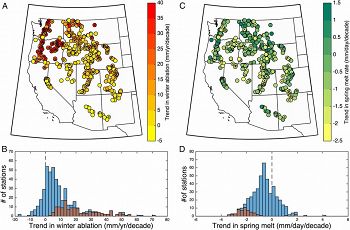Harpold & Brooks, 2018
Humidity determines snowpack ablation under a warming climate
Harpold A.A. and Brooks P.D. (2018)
PNAS 115(6): 1215-1220 Cross-CZO
-
Boulder, Catalina-Jemez, INVESTIGATOR
-
Catalina-Jemez, INVESTIGATOR
Plain English Summary
Changes in the amount and timing of snowmelt have large effects on water for society and ecosystems. Using long-term records from across the western United States, we demonstrate that atmospheric humidity is a major control on how seasonal snow responds to warming temperatures. Specifically, we observe an increase in the frequency and magnitude of episodic winter melt events under higher humidity that may alter the timing of water availability. In lower-humidity regions, however, warming is associated with increased sublimation and/or evaporation from the snowpack further reducing the amount of available water in these dry regions. Management approaches to address these changes in snowmelt water resources from continued warming will require improved estimation of variable and changing atmospheric humidity.
Abstract
Trends in winter and spring ablation over the last 3 decades. Trends in (A and B) winter ablation and (C and D) spring melt rate (C and D) from 1985 through 2015 at 462 sites. Symbol colors (A and C) represent magnitude of change, and crosses denote sites with significant trends (P < 0.05). Histograms (B and D) show the number of sites with trends at varying magnitudes (blue bars); red bars are significant trends (P < 0.05).
Climate change is altering historical patterns of snow accumulation and melt, threatening societal frameworks for water supply. However, decreases in spring snow water equivalent (SWE) and changes in snowmelt are not ubiquitous despite widespread warming in the western United States, highlighting the importance of latent and radiant energy fluxes in snow ablation. Here we demonstrate how atmospheric humidity and solar radiation interact with warming temperature to control snowpack ablation at 462 sites spanning a gradient in mean winter temperature from −8.9 to +2.9 °C. The most widespread response to warming was an increase in episodic, midwinter ablation events. Under humid conditions these ablation events were dominated by melt, averaging 21% (202 mm/year) of SWE. Winter ablation under dry atmospheric conditions at similar temperatures was smaller, averaging 12% (58 mm/year) of SWE and likely dominated by sublimation fluxes. These contrasting patterns result from the critical role that atmospheric humidity plays in local energy balance, with latent and longwave radiant fluxes cooling the snowpack under dry conditions and warming it under humid conditions. Similarly, spring melt rates were faster under humid conditions, yet the second most common trend was a reduction in spring melt rates associated with earlier initiation when solar radiation inputs are smaller. Our analyses demonstrate that regional differences in atmospheric humidity are a major cause of the spatial variability in snowpack response to warming. Better constraints on humidity will be critical to predicting both the amount and timing of surface water supplies under climate change.
Citation
Harpold A.A. and Brooks P.D. (2018): Humidity determines snowpack ablation under a warming climate. PNAS 115(6): 1215-1220. DOI: 10.1073/pnas.1716789115
 This Paper/Book acknowledges NSF CZO grant support.
This Paper/Book acknowledges NSF CZO grant support.
Explore Further



